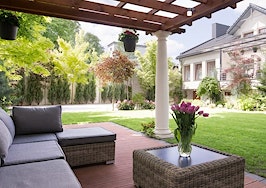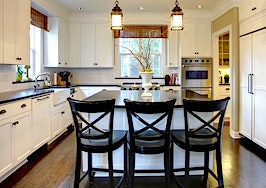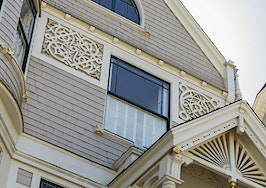- Recognizing and identifying home design styles can be tricky, but knowing the differences between each one can add to your pro status.
Ranch, Craftsman, Cape Cod, Shotgun, Tudor, Victorian, Art Deco, Mediterranean and Contemporary — they are all featured in part one of the agent’s architectural house styles cheat sheet.
But there are a number of other designs that are equally popular, as one reader reminded everyone with her comment: “What? No Colonial?!”
Here’s how to identify some of the more well-known — and a couple rare — home architectural styles.
1. Bungalow
Defining features
Bungalow-style homes originated in India, when the British wanted to provide a simple-to-build and informal place for travelers to rest and enjoy a respite from the summer heat. The style eventually made its way to the U.S. in the early 1900s when Californians became tired of the popular ornate Victorian-style homes, and longed for a simpler abode.
The home was a favorite for first-time buyers because it was so cheap to build. Sears, Roebuck and Company even sold a “Bungalow kit” in its catalog.
A bungalow home is usually one story with a wood, brick or stone exterior. It typically lacks the ornamental style of its architectural cousin, the Craftsman. These homes feature a stone chimney, low-profile roof and a covered front porch with a side entrance. The bedroom, bathroom and kitchen are usually laid around a central living space.

Bungalow – Ewelina Wachala / Shutterstock
Where is it most popular?
California and the Midwest
2. Colonial
Defining features
There are four kinds of Colonial homes: Colonial, Dutch Colonial, Georgian Colonial and Federal Colonial.
This style originated in 1600s colonial America and is known for its rectangular shape and symmetrical facade — there are always an equal number of double-hung windows on either side of the entrance. Colonial-style homes are usually two stories, with the first floor reserved for living space and the second floor dedicated to bedrooms.

Dutch Colonial – Joe Benning / Shutterstock
Each kind of colonial-style home has symmetrical facades, but there are small style changes that set them apart:
- Dutch Colonial. These homes have a broad gambrel roof and decorative hood over the entrance. They closely resemble barn houses.
- Georgian Colonial. This kind of home is very similar to its originator, except the entryway has a decorative hood similar to that of the Dutch Colonial. These homes are typically square shaped.
- Federal Colonial. These homes are the most ornate out of the bunch. They are square shaped with wings on either side. This style features a number of tall columns and other decorative features such as steps that lead to the entrance, swags, garlands, elliptical windows and a Palladian window on the second floor directly above the front door.

Federal Colonial. LEE SNIDER PHOTO IMAGES / Shutterstockho
Where is it most popular? The Northeast and East Coasts
3. Cottage
Defining features
Cottage-style homes originated in England, where peasant farmers called “cotters” lived in this quaint style of home. These homes are small, feature stone or wood facades and have gabled roofs. They are also built with an arched entryway and brick walkway.

Cottage – Chrislofotos / Shutterstock
These dwellings usually have a ton of curb appeal. Homeowners often plant a lush array of flowers and shrubbery for that ‘fairy tale’ look cottage-style homes are known for.
Where is it most popular? The Northeast
4. Italianate
Defining features
Italianate-style homes loosely resemble Italian villas and are known for the focus of ornament over actual functionality. These boxy homes feature symmetrical bay windows on the front facade; towers; tall, narrow windows on other sides of the home; and a number of small chimneys. Italianate-style homes also have decorative corbels, window cornices, columned entryways and porches.

Italianate – imging / Shutterstock
Where is it most popular? The Midwest, East Coast and California
5. National
Defining features
National-style homes are utilitarian, and they originated in the pre-railroad U.S.

National – Nkaczor58 / Shutterstock
The home has two different exterior styles — rectangular with side gabled roofs or square with a pyramidal roof. National-style homes also have two variations for the layout. The “hall-and-parlor family” layout is two rooms wide and one room deep. The “massed” layout is more than one room deep and often has side gables and shed-roofed porches.
Where is it most popular? Everywhere
6. Neoclassical
Defining features
The quintessential Neoclassical-style home is Thomas Jefferson’s Monticello in Virginia. It pulls inspiration from Ancient Greece and Classical Rome with tall columns, grand entryways and a symmetrical facade with the same number of windows on either side of the doorway. This style was a mainstay through the 1950s, and it was used for residential and commercial design.

Neoclassical – Bruce Ellis / Shutterstock
Where is it most popular? East and Midwest
7. Prairie
Defining features
In 1893, architectural legend Frank Lloyd Wright built the first Prairie-style home in suburban Chicago. Wright was inspired by the arts and crafts movement that favored simple style and practicality. This style comes in two versions — boxy and symmetrical or low-slung and asymmetrical.

Prairie – Marek Lipka-Kadaj / Shutterstock
The roofs are low-pitched, long and flat, which mirrors the Prairie landscape. The facades are usually made of brick and clapboard and feature organic designs such as floral and geometric terracotta ornamentation around the entryway, windows and cornices.
Where is it most popular? Midwest
8. Split level
Defining features
Split level homes are built to separate the various living spaces. The lowest level usually holds the garage and a television room; the mid-level is reserved for the dining and living rooms; and the uppermost level is for bedrooms. The design of the facade varies from builder to builder.

Split-level – Robert Crum / Shutterstock
Where is it most popular? East Coast and Midwest
This article includes information from Realtor.org, DIY and HGTV.










